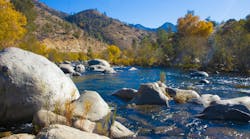Keep It To The Limit
Now that the U.S. Environmental Protection Agency (EPA) has published effluent limitations guidelines (ELGs) to control the discharge of pollutants from construction sites, it seems that contractors will be required to collect and analyze storm water samples.
The EPA regulation is already effective, and all permits issued by the agency or states must incorporate the final rule requirements. The requirements, however, will bephased in.
What is Required
All construction sites must implement specified best management practices (BMPs) for erosion, sediment and pollution control. Larger sites (20-plus acres) will be required to comply with a turbidity limit of 280 NTU. Sites of more than 10 acres will be subject to the same turbidity limit after four years. Once the turbidity limit applies, storm water must be sampled and analyzed.
Because California just reissued its permit, the state will not have to comply with the new EPA ELGs until it reissues the Construction General Permit (CGP) after it expires on Sept. 2, 2014. The reissued CGP for California has numeric action levels (NALs) and effluent limits for turbidity and pH. The action level for turbidity is 250 NTU, which is less than the EPA ELG of 280 NTU. The action level for pH is a range from 6.5 to 8.5. These numeric action levels are expected to apply to more than 90% of construction sites that disturb one or more acres.
These levels do not apply to sites with less risk. Construction sites with more risk are subject to numeric effluent limits (500 NTU and 6 to 9 pH) in addition to NALs. The California permit was written with the expectation of the onsite contractor being able to collect the required samples. The pH samples are required to be analyzed in the field. The turbidity samples can be analyzed in the field or sent for laboratory analysis.
Because the detection limit for pH analyses must be 0.2 pH, litmus paper and other colormetric analyses are not expected to be adequate. A pH meter that meets the detection limit will be required. A turbidity meter that meets the 1-NTU detection limit can be purchased for about $800. Meters for pH range in cost, starting at about $25. Meters must be calibrated to a standard in compliance with manufacturer specifications.
The contractor may choose to collect or have someone collect the turbidity samples and transport them to a lab for analysis. Samples will be required at all discharge points. For larger projects, there may be several areas where water is leaving the site in gutters, entering storm drains and other concentrated flow conveyances, and traveling through or over perimeter BMPs such as silt fence, gravel bag berms and fiber rolls.
Sampling in the Rain
Samples have to be collected in containers for analysis. Most storm water flow is on the ground. Somehow, the water on the ground has to be collected into a bottle. Scoops can be used to collect water from concentrated flow areas and then transfer the water into the bottles. When using a scoop or transfer device, care should be taken not to touch the collection device to the ground, otherwise sediment from the ground could be disturbed and add to sediment already in the water.
Samples can be collected from depressed areas that allow the sample container to be placed in flow without touching the surfaces. A sample bottle can sometimes be filled directly after removing a drain inlet grate. Samples can be collected directly into bottles if there is adequate flow.
Analyzing in the Field
Samples can be measured by following meter instructions that are made part of the Storm Water Pollution Prevention Plan. Generally, a sample is transferred into a smaller cuvette that is placed in the turbidity meter. The button is pushed, then NTU can be read directly from the meter. The pH is measured by placing a probe in the sample, and a button again allows for a direct reading.
The contract standard provisions for the California Department of Transportation and Los Angeles County Department of Public Works are expected to require the contractor to have a qualified person on site ready to collect and analyze samples. This person may delegate the sampling and analysis, but turbidity and pH sampling and analysis with meters seems straightforward enough that many contractors will be trained and able to collect samples on their own.
Once the data is collected, corrective actions will be required if the numeric action levels or effluent limits are exceeded. The new California requirements include more stringent erosion and sediment controls that can prevent exceeding of the new numeric effluent levels.
Download: Here

